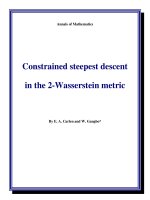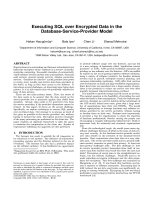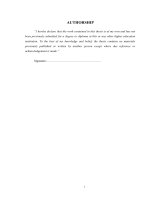- Trang chủ >>
- Khoa Học Tự Nhiên >>
- Vật lý
MOTT TRANSITIONS IN THE 2 BAND HUBBARD MODEL a COHERENT POTENTIAL APPROXIMATION STUDY
Bạn đang xem bản rút gọn của tài liệu. Xem và tải ngay bản đầy đủ của tài liệu tại đây (260.65 KB, 6 trang )
Proc. Natl. Conf. Theor. Phys. 36 (2011), pp. 182-187
MOTT TRANSITIONS IN THE 2-BAND HUBBARD MODEL:
A COHERENT POTENTIAL APPROXIMATION STUDY
DUC ANH LE
Department of Physics, Hanoi National University of Education
ANH TUAN HOANG
Institute of Physics, Hanoi, Vietnam
Abstract. The half-filled isotropic degenerate two-band Hubbard model is studied within coherent
potential approximation. The model is characterized by an Ising-type Hunds exchange coupling,
intra- and inter-orbital Coulomb parameters. We found that the band degeneracy slightly reduces
the Mott-Hubbard critical value UC . We reveal that the system can have two distinct critical values
for Mott-Hubbard transitions.
I. INTRODUCTION
The one-band Hubbard model has been used as a model for a study of strongly
correlated electronic systems such as transition metal, valence-mixing and hight TC materials. Several quantitative comparisons between the physics of three dimensional transition
metal oxides and the one-band Hubbard model give surprisingly good agreement [1, 2].
This good agreement is questionable since, normally, the simplest description of a real
system involves electrons in a two(or more)-fold degenerate level. Using slave boson (SB)
technique, Hesagawa [3] showed that the band degeneracy has strong effect on the MottHubbard transitions. The critical value UC of the double degenerate case is 1.33 times
larger than that of the one-band model. Furthermore, Ono, Potthoff, and Bulla with an
extension of the linearized dynamical mean-field theory found a linear dependence of UC
on the band degeneracy [4]. In contrast, using dynamical mean-field with iterative perturbation theory Kajueter and Kotliar [5] pointed out that the critical value UC was slightly
reduced by the band degeneracy. The purpose of this report is to study Mott-Hubbard
transitions in the doubly degenerate Hubbard model at half-filling using the coherent potential approximation (CPA) [6, 7, 8]. This self-consistent approximation is known to be
very successful in explaining single-particle properties of disordered systems and is well
suited to study the usual Hubbard model [9]. In studying the Hubbard model the CPA
has advantages over the SB and DMFT of being analytically simple. It provides some
analytical results and does not require much computer work.
MOTT TRANSITIONS IN THE 2-BAND HUBBARD MODEL...
183
II. MODEL AND FORMALISM
The two-band Hubbard model reads
∑ [
∑
]
+
H=t
fiασ
fjασ + h.c. + U
niα↑ niα↓
iα
<ij>ασ
+U ′
∑
(
niα↑ niα↓ + U ′ − J
)∑
iα
ni1σ ni2σ .
(1)
iσ
+
Here fiασ
(fiασ ) is creation (annihilation) operator for an electron at site i with spin σ
in the band α; t is hopping parameter between nearest-neighbor sites; intra- and interorbital Coulomb repulsion parametrized by U and U ′ , respectively; J is Ising-type Hunds
+
exchange coupling; niασ = fiασ
fiασ for spin σ ∈ {↑, ↓}.
We apply coherent potential approximation (CPA) to the above model. One starts from
an intuitive physical picture: an electron with spin σ can hop onto the α-orbital situated
at site i, if the orbital is either empty or occupied by an electron with spin σ
¯ . In addition,
due to the exchange and interorbital interations, the energy level of the electron also
depends on number of electrons occupied on the α
¯ orbital, i.e., orbital configurations.
Thus, the electron is considered as moving in a static random potential with eigenvalues
ε and probabilities P given by Table I [8]. The effective Hamiltonian is
∑ [
] ∑∑
+
+
fiασ
fjασ + h.c. +
(ω)fiασ
fiασ ,
(2)
H=t
iασ
<ij>ασ
ασ
∑
where ασ (ω) is CPA self-energy for spin σ at orbital α that is determined by demanding
the scattering matrix for a carrier at an arbitrarily chosen site embedded in the effective
medium vanished on average. One thus obtains average Green function
Gασ (z) =
8
∑
λ
Pασ
Gλασ (z).
(3)
λ=1
λ are calculated via the partial Green functions
Here the configurational probabilities Pασ
Gλασ (z) (see Ref. [10])).
Gασ (z)
.
(4)
1 + ( ασ (z) − ελ )Gασ (z)
Finally, the system of equations is close by requiring that the Green function of the effective
medium coincides within the lattice Green function:
∫
ρ (ω)
∑0
Gασ (z) =
dω,
(5)
z − ασ (z) − ω
Gλασ (z) =
∑
where ρ0 (ω) is the bare density of states (DOS).
184
DUC ANH LE, ANH TUAN HOANG
Config. Orbitals occupation
Energy
λ
1↑ 1↓ 2↑
2↓
ελ1↑
1
1 0 0
0
0
2
1 0 1
0
U′ − J
3
1 0 0
1
U′
4
1 1 0
0
U
′
5
1 0 1
1
2U − J
6
1 1 1
0
U + U′ − J
7
1 1 0
1
U + U′
8
1 1 1
1
U + 2U ′ − J
Probabilities
λ
P1↑
⟨(1 − n1↓ )(1 − n2↑ )(1 − n2↓ )⟩
⟨(1 − n1↓ )n2↑ (1 − n2↓ )⟩
⟨(1 − n1↓ )(1 − n2↑ )n2↓ ⟩
⟨n1↓ (1 − n2↑ )(1 − n2↓ )⟩
⟨(1 − n1↓ )n2↑ n2↓ ⟩
⟨n1↓ n2↑ (1 − n2↓ )⟩
⟨n1↓ (1 − n2↑ )n2↓ ⟩
⟨n1↓ n2↑ n2↓ ⟩
λ
Table 1. Energy levels ϵλ1↑ and configuration probabilities P1↑
for a 1↑ electron.
′
U , U , and J are the intraorbital Coulomb interaction, the interorbital Coulomb
interaction, and the exchange interaction, respectively. nασ is the average occupation of electrons with spin σ on the α orbital. Similar tables exist for the 1↓,
2↓, and 2↑ electrons. Taken from Ref. [8].
0.60
0.40
U = 0.5 W
Density of states
0.20
0.00
0.60
0.40
Single band
Two bands
U = 1.0 W
0.20
0.00
0.60
0.40
U = 1.5 W
0.20
0.00
-3.0
-2.5
-2.0
-1.5
-1.0
-0.5
0.0
ω
0.5
1.0
1.5
2.0
2.5
3.0
Fig. 1. DOS of the one-band (U ′ = 0) and two-band (U ′ = U ) models for J = 0
and different values of U .
III. RESULTS AND DISCUTIONS
The self-energy and the Green function are obtained by iterations [7] which can be
done for arbitrary lattice structure. Here for convenient we chose ρ0 (ω) is the DOS of the
Bethe lattice at infinite dimension:
ρ0 (ε) =
2 √ 2
W − ε2 .
π W2
(6)
MOTT TRANSITIONS IN THE 2-BAND HUBBARD MODEL...
2.0
F
1.5
1.0
Single band
Two bands
0.5
0.0
0.0
0.2
0.4
0.6
0.8
1.0
1.2
1.4
U
Fig. 2. Mott-Hubbard transitions in the one- and two-band models.
0.6
0.5
U = 0.5 W
U = 1.5 W
0.4
F
U = 2.0 W
0.3
0.2
0.1
0.0
0.0
0.5
1.0
1.5
2.0
2.5
U'
Fig. 3. DOS at the Fermi level as a function of U ′ for J = 0 and different values of U .
185
186
DUC ANH LE, ANH TUAN HOANG
0.25
J = 0.0 U'
J = 0.25U'
J = 0.5U'
0.20
J = 0.25U
EF
0.15
0.10
0.05
0.00
0.0
0.5
1.0
1.5
2.0
U'
Fig. 4. DOS at the Fermi level as a function of U ′ for U = 1.5W and different
values of J.
Since the system is isotropic the Fermi energy EF is exactly located at the origin.
The Mott transitions appear simutanously on two orbitals. In order to show the effect of
the band degeneracy, we compare results of the single-band model (U ′ = 0, J = 0) with
that of the two-band models (U ′ = U, J = 0). Fig. 1 shows the DOS of the single band
and two-band models for various values of U . It is seen that the band degeneracy only
slightly changes the DOS near Fermi level, however, it does make different at the band
edges. As a result, see Fig. 2, it inconsiderably changes the Mott transition which is characterized by the DOS at Fermi level. That means CPA result is in very good agreement
with dynamical mean-field plus iterative perturbation theory by Kajueter and Kotliar [5].
By means of a generalized mean-field approximation, Didukh et al. [11] obtained similar
results, except the fact that the effect of the band degeneracy was stronger than that
predicted by DMFT and CPA.
When U > 1.0W both the single-band and two-band models are in isulating phase.
Fig. 3 shows how the groundstate of the two-band system changes when varying U ′ for
J = 0 and different values of U . For U = 0.5W fixed, inscreasing U ′ from 0, the system
will undergo a metal-insulator transition once U ′ exceeds a critical value. On the other
hand, for U = 1.5W , the system goes through a small metallic region in the insulating
domain when inscreasing U ′ , i.e., here are two distinct Mott-Hubbard transitions. The
latter has been obtained within DMFT (exact diagonalization as the inpurity solvers) by
Koga et al.[12, 13] who argued that orbital fluctuations induced by the interband Coulomb
interaction drives the system to the metallic phase. Fig. 4 shows effect of the Hund’s
MOTT TRANSITIONS IN THE 2-BAND HUBBARD MODEL...
187
exchange interaction J on the Mott transitions of the system changes when varying U ′ for
U = 1.5W . It is seen that the effect of the Hunds coupling is to broaden and shift the
metallic peak to higher values of the interorbital interaction.
IV. CONCLUSIONS
We have applied coherent potential approximation for the half-filled isotropic degenerate two-band Hubbard model to study Mott-Hubbard transitions. We found that
the orbital degeneracy slightly reduces the Mott-Hubbard critical value UC . We showed
that CPA results are in good agreement with DMFT. However, CPA requires less computer work, that enables one to consider all possible values of the system parameters. The
results here can be extended to the anisotropic multiband model to study the so-called
orbital-selective Mott transition, which has been received much of attention during the
past few years. This is left to future work.
ACKNOWLEDGMENT
The authors acknowledge the National Foundation of Science and Technology Development (NAFOSTED) for support.
REFERENCES
[1]
[2]
[3]
[4]
[5]
[6]
[7]
[8]
[9]
[10]
[11]
[12]
[13]
M. J. Rozenberg et al., Phys. Rev. Lett. 75 (1995) 105.
G. Moeller, Phys. Rev. B 53 (1996) 16214.
H. Hesagawa, J. Phys. Soc. Jpn. 66 (1997) 1391.
Y. Ono, P. Potthoff, S. Bulla, Phys. Rev. B 67 (2003) 035119.
H. Kajueter, G. Kotliar, Int. J. Mod. Phys. B 11 (1997) 729.
B. Velicky, S. Kirkpatrick, H. Ehrenreich, Phys. Rev. 175 (1968) 747.
F. Ducastelle, J. Phys. C: Sol. Stat. Phys. 7 (1974) 1795.
C. Lacroix-Lyon-Caen, M. Cyrot, Sol. Stat. Com. 21 (1977) 837.
F. Gebhard, The Mott MetalInsulator Transition: Models and Methods, 1997 Springer, New York.
J. van der Rest, F. Brouers, Phys. Rev. B 24 (1981) 450.
L. Didukh et al., Phys. Rev. B 61 (2000) 7893.
A. Koga et al., Phys. Rev. B 66 (2002) 165107.
A. Koga et al., J. Phys. Soc. Jpn. 72 (2003) 1306.
Received 30-09-2011.









